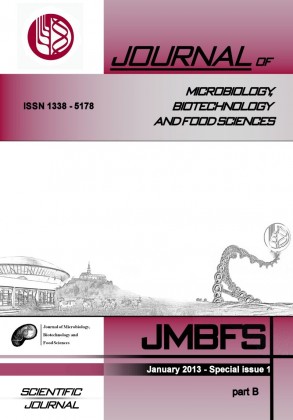ASSOCIATIONS OF DGAT1 POLYMORPHISM WITH MILK CHARACTERISTICS IN SLOVAK DAIRY COWS
Keywords:
genetic marker, cattle, acyl-CoA:diacylglycerol acyltransferase gene (DGAT1), PCR-RFLPAbstract
DGAT1 encodes diacylglycerol O-acyltransferase (EC 2.3.1.20), a microsomal enzyme that catalyzes the final step of triglyceride synthesis. It was shown that the QTL variation is most likely caused by a nonconservative base substitution in the candidate gene DGAT1 changing lysine to alanine (K232A) in the enzyme diacylglycerol O-acyltransferase (DGAT). In particular, the allele encoding the lysine 232 variant proved to be more efficient with regard to milk fat synthesis. The objective of the present study was to determine the allele frequencies and to verify the effects of the two DGAT variants (K232A polymorphism, A and K alleles) on milk production traits in Slovak dairy cows.Samples of 196 dairy cows originating from 61 sires were genotyped for DGAT1 K232A polymorphism (A and K alleles) using the PCR-RFLP technique. The frequencies of DGAT1 alleles were 0.88 (A) and 0.12 (K). The performance data were collected during one season in order to minimize this effect. The overall milk yield (MILK), fat yield (FAT_Y), fat content (FAT_C), protein yield (PROT_Y), protein content (PROT_C) and age at first calving (AGE1) were studied. The effect of DGAT1 polymorphism on fat and protein content in milk was confirmed. Further study is needed for explanation of effect of DGAT1 on the age at first calving.
Downloads
Download data is not yet available.
Downloads
Published
2013-02-01
How to Cite
VaÅ¡ÃÄková, K., Tomka, J., Bauer, M., Huba, J., & VaÅ¡ÃÄek, D. (2013). ASSOCIATIONS OF DGAT1 POLYMORPHISM WITH MILK CHARACTERISTICS IN SLOVAK DAIRY COWS. Journal of Microbiology, Biotechnology and Food Sciences, 2(special issue 1), 2025–2031. Retrieved from https://office2.jmbfs.org/index.php/JMBFS/article/view/7299
Issue
Section
Biotechnology
License
Copyright (c) 2013 KatarÃÂna VaÅ¡ÃÄková, Ján Tomka, Miroslav Bauer, Ján Huba, DuÅ¡an VaÅ¡ÃÄek

This work is licensed under a Creative Commons Attribution 4.0 International License.
All papers published in the Journal of Microbiology, Biotechnology and Food Sciences are published under a CC-BY licence (CC-BY 4.0). Published materials can be shared (copy and redistribute the material in any medium or format) and adapted (remix, transform, and build upon the material for any purpose, even commercially) with specifying the author(s).

